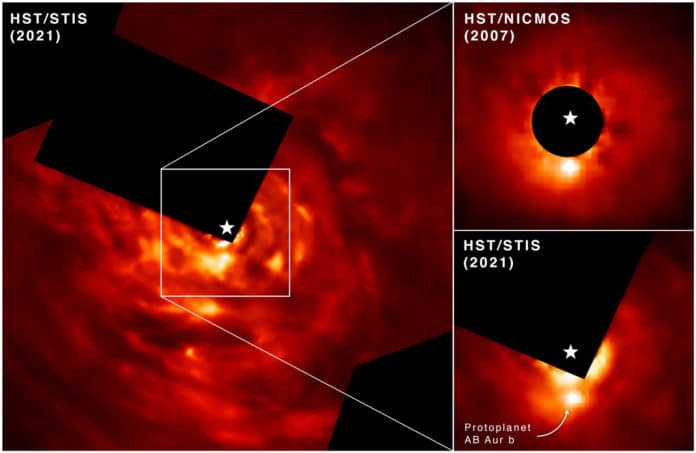NASA’s Hubble Space Telescope recently captured a protoplanet- forming via an ‘intense and violent process.’ The planet is forming in a protoplanetary disk with a distinct spiral structure swirling around surrounding a young star that’s approximately 2 million years old.
Scientists dubbed this planet AB Aurigae b. It is claimed to be nine times more massive than Jupiter. It orbits its host star at a whopping distance of 8.6 billion miles. At that distance, it would take a very long time.
Scientists suggest that the planet is forming at such a huge distance due to disk instability. And this is contrary to expectations of planet formation by the widely accepted core accretion model.
For the analysis, scientists combined data from two Hubble instruments: the Space Telescope Imaging Spectrograph and the Near Infrared Camera and Multi-Object Spectrograph. They compared the data to those from an advanced planet imaging instrument called SCExAO on Japan’s 8.2-meter Subaru Telescope located at the summit of Mauna Kea, Hawaii.
Thayne Currie, the lead researcher on the study, said, “Interpreting this system is extremely challenging. This is one of the reasons why we needed Hubble for this project – a clean image to better separate the light from the disk and any planet.”
“Hubble’s longevity played a particular role in helping researchers measure the protoplanet’s orbit. He was originally very skeptical that AB Aurigae b was a planet. The archival data from Hubble, combined with imaging from Subaru, proved to be a turning point in changing his mind.”
“We could not detect this motion for a year or two years. Hubble provided a time baseline, combined with Subaru data, of 13 years, which was sufficient to detect orbital motion.”
Olivier Guyon of the University of Arizona, Tucson, and Subaru Telescope, Hawaii said, “This result leverages ground and space observations. We get to go back in time with Hubble’s archival observations. AB Aurigae b has now been looked at in multiple wavelengths, and a consistent picture has emerged – a very solid one.”
Alan Boss of the Carnegie Institution of Science in Washington, D.C., emphasized, “This discovery is strong evidence that some gas giant planets can form by the disk instability mechanism. In the end, gravity is all that counts, as the leftovers of the star-formation process will end up being pulled together by gravity to form planets, one way or the other.”
Journal Reference:
- Currie, T., Lawson, K., Schneider, G., et al. Images of embedded Jovian planet formation at a wide separation around AB Aurigae. Nat Astron (2022). DOI: 10.1038/s41550-022-01634-x
